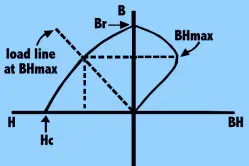Quick Links
The Most Commonly Used Permanent Magnets
Ceramic (ferrite) magnet material was first formulated in the 1950s and then further developed in the 1960s as a less expensive alternative to other types of magnet materials. The major raw materials used to manufacture ceramic magnets are iron oxide (commonly known as rust)and strontium carbonate. When these materials are mixed together at elevated temperatures ranging from 1800-2000 degrees F, a chemical conversion occurs which creates the ferrite material. Due to their low cost, ceramic magnets are the most commonly used permanent magnets today.
A special form of ferrite magnets is produced using a flexible binder for the ferrite powder. These materials are commonly referred to as "flexible magnets".Integrated Magnetics designs and builds custom technical ceramic magnetsand magnetic assemblies, manufactured to meet your specialty requirements. Send us a request for quote or contact us today for more information about standard or custom ceramic magnets. Large inventory of ceramic magnets are also available for on-line purchase at MagnetShop.com.
Key Benefits of Ceramic Magnet Material
- Inexpensive yet strong; a good balance between strength and affordability.
- Does not demagnetize easily.
- Can be magnetized with multiple poles if necessary.
- Does not rust.
Key Challenges of Ceramic Magnet Material
- Hard and brittle.
- Properties degrade linearly with temperature. At 350°F (177°C), about 75% of room temperature magnetization is retained, and at 550°F (288°C), about 50% is retained.
Quick Facts about Ceramic Magnet Material>
- Density: 0.180 lbs. per cubic inch.
- Saturation magnetizing field required: about 10kOe.
- Manufacturing methods: sintering (most common), injection molding, extruding or calendering (the last 3 methods when the material is combined with a carrier). Fully dense sintered ferrite magnets can be wet or dry pressed (wet pressing leads to higher magnetic properties).
- Available Shapes:blocks, bars, discs, rings, arc segments, etc.
- Available Grades: from 0103 to 0404. (First 2 digits represent BHmax, and second two digits represent Intrinsic Coercivity, or Hci).
- Sizes: sintered ferrite magnets can be manufactured in blocks up to approximate 10" x 4" x 1". Extruded ferrite (otherwise known as flexible magnets) can be extruded in unlimited lengths. However, the energy product of flexible magnets is much lower than that of fully dense, sintered ferrite magnets.
Surface Treatments for Ceramic Magnet Material
- No surface treatments are necessary for ceramic magnets since they are essentially inert and do not oxidize. However, they can be coated with various epoxy coatings for cleanliness purposes.
Caution!
Ferrite materials are very hard and brittle and will shatter if dropped; special care must be taken when handling these magnets.









